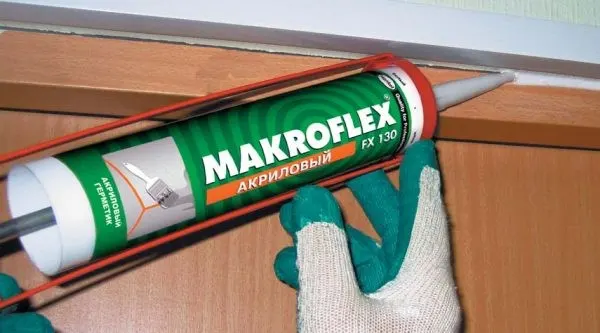Acrylic-based sealants are a common choice for home renovation and construction projects and are highly adaptable. These sealants are preferred for their superior flexibility and adhesion to a wide range of surfaces and applications. Used to fill spaces around windows, doors, and other fixtures, acrylic-based sealants provide a stable, long-lasting bond that won’t fade over time.
One of the main advantages of acrylic sealants is their ease of use. It can be applied evenly and smoothly with a caulking gun, and it’s simple to clean with water before hardening. As a result, they are the best choice for experienced contractors and do-it-yourselfers. In addition, the brushable acrylic sealant allows the sealing area to smoothly blend with the surrounding surface for a polishing effect.
Another important feature of acrylic sealants is that they are environmentally friendly. Acrylic sealants are safer to use indoors because they contain fewer volatile organic compounds (VOCs) than some other types of sealants, while some other types of sealants release strong odors and potentially harmful fumes. To ensure the longevity and durability of the sealant, the sealant also has UV resistance, which helps prevent the sealant from cracking and aging when exposed to sunlight.
While acrylic sealants have many advantages, it’s also important to understand their limitations and specific uses. They’re ideal for use indoors and in places with little exposure to nature or water. For exterior applications or areas with high humidity, it is critical to choose a sealant that can survive in harsh environments. Knowing these details, you’ll be able to choose the best sealant for your project and be guaranteed the best results.
Acrylic-based sealants are a versatile, easy-to-use material that is ideal for a variety of sealing applications, both indoors and outdoors. Because acrylic sealants adhere well to a variety of surfaces such as masonry, metal, wood, and glass, they are an ideal material for filling gaps, cracks, and joints. These sealants are brushable, dry quickly, and provide a strong and resilient seal that won’t crack due to movement and weathering. If you understand the unique properties and application methods of acrylic sealants, you can achieve a long-lasting, high-quality finish for any project.
Features and properties of sealants
Acrylic sealant is an acrylic resin-based ingredient that is used to waterproof and seal a variety of seams and joints. Beginners should use an acrylic sealant because it is very easy to handle and does not freeze for a long time to hold the seams in place. The product can be painted or plastered after drying, and has a certain elasticity and vibration adaptability.
Simply pour the acrylic sealant into the various holes and cracks and allow it to dry before use. They exhibit excellent performance indoors, adapting to changes in temperature and humidity while being deformed. However, street conditions are not ideal for these ingredients: ordinary sealants that do not contain specific antifreeze additives can become too hard and may crack in the cold.
Technical parameters of acrylic sealant
An essential quality indicator of an acrylic sealant is the maximum elongation under maximum stress. If stretched and exposed beyond this indicator, this effect will be permanently deformed. The larger the pattern, the better the elasticity of the sealant. In general, an index of 10% or higher is sufficient to judge the hardness and quality of the sealant. The product has 11-12% elasticity and is suitable for outdoor use.
Other technical details of the sealant:
possible seam width – 6-50 mm (for widths exceeding 6 mm, additional sealing ropes are required);
The optimal seam thickness is 1/2 of its width;
Operating temperature – from -15 … -20 to +70 degrees or higher;
The time for film to appear on the surface of the seam is 15 minutes;
The surface sealing period is 1 hour;
Drying time – 24 hours, moisture content 50%, temperature +23°;
Frost resistance (special composition) – 5 freeze and thaw cycles;
The average rupture rate is 550.
Acrylic-based sealants are packaged in tubes, drums, tubes, and other containers. Only packaged money can be kept at room temperature for up to a year.
Composition of the sealant
Water-dispersible acrylic copolymers (polymethyl methacrylate) make up 50–90% of the composition. Plasticizers are added to improve plasticity because the material becomes strong and plastic-like when solidified. Acrylic sealants may also contain the following materials:
Foaming;
ammonia in the form of an aqueous solution;
thickeners;
Stuffing;
Preservative;
Pea.
Fields of application
The sealant does not contain solvents or other harmful substances and is an ideal material for interior decoration. Even in enclosed spaces, it can be used without wearing personal protective equipment. The most common application of acrylic sealants is at the joints between logs and wood. Acrylic sealants provide good adhesion to porous building materials and are best suited for wood and concrete.
For example, acrylic ingredients can be used instead of building glue to bond ceiling baseboards. It can be used to join moldings, long sticks, rounded corners, and seams that separate them from the surface. While gluing the ceiling, it is also possible to fill in the gaps that arise with acrylic sealant.
The difference between acrylic sealant and silicone
Silica gel and acrylic compounds differ in performance and application characteristics:
The acrylic sealant can be treated with seams after hardening. Any color of acrylic, latex, and other water paints can be easily stained. If necessary, individual seams can be repaired and partially renewed. Paint doesn’t turn silicone or fade quickly.
Acrylic sealants can be mechanically treated: grinding, drilling. Silicone has this effect and can be completely separated, damaging the joints.
Acrylic is an order of magnitude worse moisture resistance than silicone. The basis of acrylic sealants is an aqueous dispersion of acrylates so they will still dissolve. Silicone is a rubber-like waterproof material.
Acrylic sealants are also not as good as silicone sealants when it comes to elasticity. Silicone sealants are more malleable, have less shrinkage, and have a longer stretch distance without causing damage.
Acrylic is permeable to water vapor, while silicone is impermeable. Thanks to this property, the acrylic compound does not disrupt the indoor microclimate and does not lead to the accumulation of steam and moisture.
Acrylates have excellent adhesion to porous building materials and are best suited for wood, concrete, etc. Before sealing, sandpaper or other methods should be used to treat the smooth ground to improve the quality of the bonding.
The color scheme of the acrylic component is more abundant. If you want, you can choose the appropriate remedy for any shade, including different woody species. Silicone agents are produced in a limited range (typically white, black, gray, and red).
Silicone is very durable – it can last up to 20 years. Acrylics start aging earlier because they become more noticeable over time.
The price of acrylic preparations is always lower than the price of silicone. The average difference is 30-50%, which is very important for many users.
The environmental friendliness of acrylic is beyond doubt. Such funds are completely safe for people and the environment. Silicone sealants can produce an unpleasant odor on an acidic basis, so they should not be used regularly.
As long as there is no constant water contact or excessive humidity, the acrylic component works well indoors. These funds are essential if the joints need to be painted in the future. They are commonly used for pipe leaks, door crack seals, and window frame cracks. Silicone sealants can seal aquarium walls and other items that come into contact with water, making them suitable for use outdoors and in bathrooms. However, metal, concrete, and natural stone cannot be sealed with acidic silicone sealants; Acrylic sealants are suitable for these situations.
Type of sealant
All acrylic sealants can be conditionally divided into three categories. The introduction of different additives and handling characteristics has led to product differentiation.
Inexhaustible
Assuming low or normal humidity, these products are only suitable for indoor use. Ideal for minor repairs, building construction, glued baseboards and baguettes. Works well with substrates made of wood, brick, concrete and GKL.

